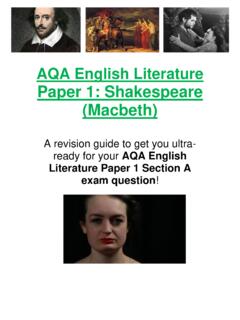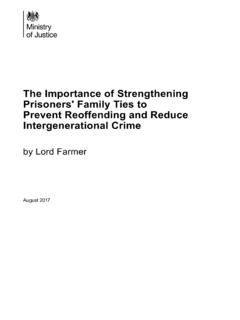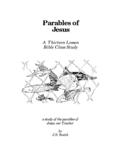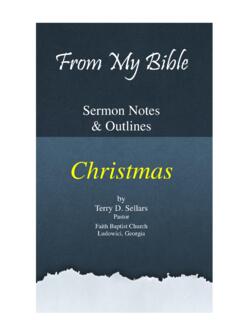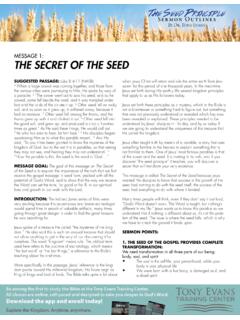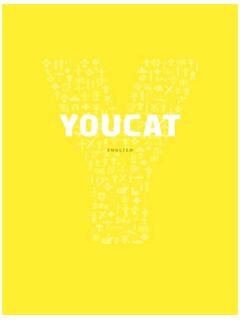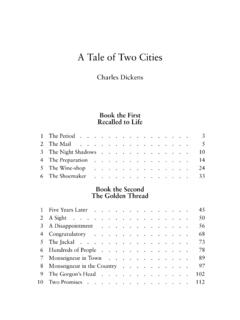Transcription of English GCSE Literature Paper 2 Poetry Revision Guide
1 Power and Conflict English GCSE. Literature Paper 2. Poetry Revision Guide Get yourself ultra-ready for your English Literature GCSE exam with this helpful Revision Guide . Introduction There are fifteen poems that you will have studied in preparation for the Poetry section of your GCSE English Literature Paper 2 exam. They are as follows: The Prelude Storm on the Island Exposure The Charge of the Light Brigade Bayonet Charge Remains Poppies War Photographer Kamikaze Ozymandias London My Last Duchess The migr e Checking Out Me History Tissue In Section A of your exam you will be given one of these poems which will be included in full in the exam booklet. However, you will also need to compare this given poem to one other in the collection based around a theme that will be given to you. Here is an example: Compare the ways the poets present ideas about anger in Checking Out Me History' and one other poem from Power and Conflict'.
2 In order to do this you will need to think carefully about which poems fit into which particular themes or ideas. Revision Activity: Comparing Poems Use your knowledge of the 15 anthology poems to tick off every theme you think each poem fits into. This should help you see which poems would work best together in the exam. 4: Complete the table, ticking off all the relevant boxes for exam poem. 5: Which poems would be best to compare with Checking Out Me History on the theme of anger? Make notes on how anger is shown in the two poems you choose and how it is similar or different to Checking Out Me History. 6: Begin writing out an answer to this exam question and think about how you are showing your comparisons in your answer. Poem The The The The Loss or Memory Anger Guilt Fear Pride Identity Powerful Lack of Abuse Power Power Effects Reality Absence Emotions Power of of of of of Power Humans Nature Conflict Conflict The Prelude Storm on the Island Exposure The Charge of the Light Brigade Bayonet Charge Remains Poppies War Photographer Kamikaze Ozymandias London My Last Duchess The migr e Checking Out Me History Tissue Now that you've thought about how you will link the poems together, it would be a good idea to recap every poem in detail.
3 Over the next 15 pages you will find detailed information and analysis on each poem, plus ways of helping you make notes on every poem in the collection. The Prelude What happens in the poem? The speaker is out walking in the Lake District, an area of England that is known for its stunning natural beauty (mountains, trees, plants, and flowers essentially, beautiful countryside). When out walking the speaker find a boat and steals it. During his journey he describes the natural world around him and seems full of admiration and happiness, but then his mood change as he encounters an enormous, black mountain. This fills him with fear and dread. The speaker then decides to head home, but his whole view of nature has been fundamentally altered. Context: William Wordsworth belonged to a group of poets known as the Romantics.
4 The Romantics were a group of writers, artists and musicians from the late 18th century into the early 19th century. The Romantics had a very clear political philosophy and they wanted to stop the exploitation of the poor by the wealthy. Rather than following the rules of society, the Romantics believed every person should follow their own ideals. They felt it very important that people only express their personal feelings. They also felt a sense of responsibility to everyone in society: they felt it was their duty to use their work to change society. What is this poem about? This can be quite a difficult poem for students to get their heads around; this is because Wordsworth is being very metaphorical. The nature that surrounds him is a representation of his state of mind: at first he is confident, self-assured and ultimately happy, but later his mood completely alters.
5 He becomes anxious, fearful and scared. It is about a man finding his own identity and how he fits into the world around him. Structure: The extract from The Prelude is written in blank verse, or unrhyming lines of iambic pentameter (ten syllabies a line: 5 bars, 2 beats per bar). Iambic pentameter is the type of meter that best mimics natural speech and presents a realistic representation of the speaker's thoughts and feelings. At times the poem employs enjambment (where lines carry on into each other) to represent an overflowing of emotions. Language: Go through the poem and using highlighters or coloured pens: Highlight all the parts of the poem which show a positivity to nature Highlight all the parts of the poem which show a negativity towards nature Highlight all the examples of the speaker personifying nature and explain why the speaker does this.
6 The speaker uses the pronoun her' on a number of occasions in this extract. Why does he do this? Who might her' be? Which is it feminine? What do you notice about positivity and negativity within this poem? What does this tell you about the speaker's thoughts? Storm on the Island What happens in the poem? An isolated community is preparing itself for the onslaught of a severe storm. The speaker describes the preparations, his thoughts and feelings about the storm, the storm itself and how it affects him. Context: Seamus Heaney grew up in rural Northern Ireland, where his father was a farmer. Much of Heaney's Poetry focuses on the countryside of his childhood and his descriptions of nature can often act as metaphors for human behaviour in many ways this is similar to Wordsworth's The Prelude'. Heaney spent much of his life living and teaching in Northern Ireland and devoted himself to his writing.
7 What is this poem about? Like many of Heaney's other poems, this one is packed with images of nature. He describes the work the people of the community are doing to ensure they are protected from the oncoming storm; the speaker also describes the power of the storm through very military-like imagery and shows the growing strength of it, but ultimately this is a huge nothing' that they fear- which is the wind. Structure: The poem is presented in one stanza, which could be used to represent the isolation of the island within the storm. Both enjambment and caesuras are used at times throughout the poem to emphasise the preparations of the people on the island and the ferocious power of the storm. Moreover, the poem is presented in blank verse: 19 lines of unrhyming iambic pentameter. Again, like The Prelude', iambic pentameter is used as it best represents the natural way of speaking.
8 When you couple this with the at times informal language of the speaker ( you know what I mean ) it feels as if the speaker is addressing us directly. Language: Highlight all the parts of the poem which shows the people on the island are well prepared and are safe. Highlight all the parts of the poem which show the power of the storm. Find all the military images used within in the poem. What do you think is the conflict within the poem? What do you think is the speaker's attitude towards the storm? Why? At which points is the poem at its most tense? When is it least tense? Why do you think Heaney constructed his poem like this? Exposure What happens in this poem? A group of soldiers during the First World War are waiting around in the trenches before they are given orders to go over the top' and fight. During this time, the speaker describes the horrendous weather conditions that surround the soldiers and threaten to kill them: they are shown to be another type of enemy.
9 Indeed, many soldiers did perish because of the appalling conditions rather than because of the fighting itself. The speaker mentions about soldiers remembering being back home, but ultimately nothing happens' in this poem. Context: Wilfred Owen fought during the First World War and was killed just before the war ended. He used his writing abilities to create deeply cynical and angry p oems about the War and the reasons why it had happened. Owen's works were very unusual at a time when most writing about the war had been deeply patriotic. What is this poem about? Owen was disgusted by the war and what he perceived as the utterly futile or pointless nature of it. Thousands of young men seemed to be losing their lives in horrifying ways for no reason. In this poem, Owen turns his focus to the weather and how it too becomes an enemy to the soldiers.
10 Structure: This poem is divided up into eight stanzas of five lines each (using iambic hexameter lines of eight syllables), with each final line being indented and shorter than the rest. These shorter lines help to provide a type of final idea to each stanza that emphasises the speaker's thoughts and feelings regarding the war. They are often framed as rhetorical questions, asking the reader question the point of these men being exposed to these conditions. Language: Highlight all the words which show existing in these conditions was incredibly tough. Find all the words which show the speaker is not the only one who is suffering in these conditions. Find the examples of negative imagery being used in the poem. How is the weather described? Why do you think the speaker chose to personify the weather in this way?



